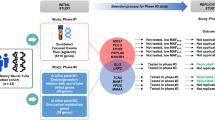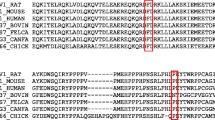Abstract
Genetic variants in MTHFD1 (5,10-methylenetetrahydrofolate dehydrogenase/5,10-methenyltetrahydrofolate cyclohydrolase/ 10-formyltetrahydrofolate synthetase), an important folate metabolic enzyme, are associated with a number of common diseases, including neural tube defects (NTDs). This study investigates the promoter of the human MTHFD1 gene in a bid to understand how this gene is controlled and regulated. Following a combination of in silico and molecular approaches, we report that MTHFD1 expression is controlled by a TATA-less, Initiator-less promoter and transcription is initiated at multiple start sites over a 126 bp region. We confirmed the presence of three database polymorphisms (dbSNP) by direct sequencing of the upstream region (rs1076991 C > T, rs8010584 G > A, rs4243628 G > T), with a fourth (dbSNP rs746488 A > T) not found to be polymorphic in our population and no novel polymorphisms identified. We demonstrate that a common SNP rs1076991 C > T within the window of transcriptional initiation exerts a significant effect on promoter activity in vitro. We investigated this SNP as a potential risk factor for NTDs in a large homogenous Irish population and determined that it is not an independent risk factor, but, it does increase both case (χ 2 = 11.06, P = 0.001) and maternal (χ 2 = 6.68, P = 0.01) risk when allele frequencies were analysed in combination with the previously identified disease-associated p.R653Q (c.1958 G > A; dbSNP rs2236225) polymorphism. These results provide the first insight into how MTHFD1 is regulated and further emphasise its importance during embryonic development.



Similar content being viewed by others
References
Barlowe CK, Appling DR (1990) Molecular genetic analysis of Saccharomyces cerevisiae C1-tetrahydrofolate synthase mutants reveals a noncatalytic function of the ADE3 gene product and an additional folate-dependent enzyme. Mol Cell Biol 10:5679–5687
Brandeis M, Frank D, Keshet I, Siegfried Z, Mendelsohn M, Nemes A, Temper V, Razin A, Cedar H (1994) Sp1 elements protect a CpG island from de novo methylation. Nature 371:435–438
Brody LC, Conley M, Cox C, Kirke PN, McKeever MP, Mills JL, Molloy AM, O’Leary VB, Parle-McDermott A, Scott JM, Swanson DA (2002) A polymorphism, R653Q, in the trifunctional enzyme methylenetetrahydrofolate dehydrogenase/methenyltetrahydrofolate cyclohydrolase/formyltetrahydrofolate synthetase is a maternal genetic risk factor for neural tube defects: report of the Birth Defects Research Group. Am J Hum Genet 71:1207–1215
Busby A, Abramsky L, Dolk H, Armstrong B (2005) Preventing neural tube defects in Europe: population based study. Br Med J 330:574–575
Cam H, Balciunaite E, Blais A, Spektor A, Scarpulla RC, Young R, Kluger Y, Dynlacht BD (2004) A common set of gene regulatory networks links metabolism and growth inhibition. Mol Cell 16:399–411 Supplemental Data
Cheng J, Zhu WL, Dao JJ, Li SQ, Li Y (2005) Relationship between polymorphism of methylenetetrahydrofolate dehydrogenase and congenital heart defect. Biomed Environ Sci 18(1):58–64
Christensen KE, Rohlicek CV, Andelfinger GU, Michaud J, Bigras JL, Richter A, Mackenzie RE, Rozen R (2008) The MTHFD1 p.Arg653Gln variant alters enzyme function and increases risk for congenital heart defects. Hum Mutat [Epub ahead of print]
Czeizel AE, Dudas I (1992) Prevention of the first occurrence of neural-tube defects by periconceptional vitamin supplementation. N Engl J Med 327:1832–1835
De Marco P, Merello E, Calevo MG, Mascelli S, Raso A, Cama A, Capra V (2006) Evaluation of a methylenetetrahydrofolate-dehydrogenase 1958G > A polymorphism for neural tube defect risk. J Hum Genet 51(2):98–103
Dong S, Lester L, Johnson LF (2000) Transcriptional control elements and complex initiation pattern of the TATA-less bidirectional human thymidylate synthase promoter. J Cell Biochem 77:50–64
Furness DL, Fenech MF, Khong YT, Romero R, Dekker GA (2008) One-carbon metabolism enzyme polymorphisms and uteroplacental insufficiency. Am J Obstet Gynecol 199(3):276.e1–278.e1
Gong M, Cowan KH, Gudas J, Moscow JA (1999) Isolation and characterization of genomic sequences involved in the regulation of the human reduced folate carrier gene (RFC1). Gene 233:21–31
Hermann S, Berndt KD, Wright AP (2001) How transcriptional activators bind target proteins. J Biol Chem 276:40127–40132
Hol FA, van der Put NM, Geurds MP, Heil SG, Trijbels FJ, Hamel BC, Mariman EC, Blom HJ (1998) Molecular genetic analysis of the gene encoding the trifunctional enzyme MTHFD (methylenetetrahydrofolate-dehydrogenase, methenyltetrahydrofolate-cyclohydrolase, formyltetrahydrofolate synthetase) in patients with neural tube defects. Clin Genet 53:119–125
Hoogendoorn B, Coleman SL, Guy CA, Smith K, Bowen T, Buckland PR, O’Donovan MC (2003) Functional analysis of human promoter polymorphisms. Hum Mol Genet 12:2249–2254
Howard KM, Muga SJ, Zhang L, Thigpen AE, Appling DR (2003) Characterization of the rat cytoplasmic C1-tetrahydrofolate synthase gene and analysis of its expression in liver regeneration and fetal development. Gene 319:85–97
Hum DW, Bell AW, Rozen R, MacKenzie RE (1988) Primary structure of a human trifunctional enzyme. Isolation of a cDNA encoding methylenetetrahydrofolate dehydrogenase-methenyltetrahydrofolate cyclohydrolase-formyltetrahydrofolate synthetase. J Biol Chem 263:15946–15950
Kempisty B, Sikora J, Lianeri M, Szczepankiewicz A, Czerski P, Hauser J, Jagodzinski PP (2007) MTHFD 1958G>A and MTR 2756A>G polymorphisms are associated with bipolar disorder and schizophrenia. Psychiatr Genet 17(3):177–181
Kirke PN, Molloy AM, Daly LE, Burke H, Weir DG, Scott JM (1993) Maternal plasma folate and vitamin B12 are independent risk factors for neural tube defects. Q J Med 86:703–708
Mao DY, Watson JD, Yan PS, Barsyte-Lovejoy D, Khosravi F, Wong WW, Farnham PJ, Huang TH, Penn LZ (2003) Analysis of Myc bound loci identified by CpG island arrays shows that Max is essential for Myc-dependent repression. Curr Biol 13(10):882–886
McEwan IJ, Dahlman-Wright K, Ford J, Wright AP (1996) Functional interaction of the c-Myc transactivation domain with the TATA binding protein: evidence for an induced fit model of transactivation domain folding. Biochemistry 35:9584–9593
Parle-McDermott A, Mills JL, Kirke PN, Cox C, Signore CC, Kirke S, Molloy AM, O’Leary VB, Pangilinan FJ, O’Herlihy C, Brody LC, Scott JM (2005a) MTHFD1 R653Q polymorphism is a maternal genetic risk factor for severe abruptio placentae. Am J Med Genet A 132:365–368
Parle-McDermott A, Pangilinan F, Mills JL, Signore CC, Molloy AM, Cotter A, Conley M, Cox C, Kirke PN, Scott JM, Brody LC (2005b) A polymorphism in the MTHFD1 gene increases a mother’s risk of having an unexplained second trimester pregnancy loss. Mol Hum Reprod 11:477–480
Parle-McDermott A, Kirke PN, Mills JL, Molloy AM, Cox C, O’Leary VB, Pangilinan F, Conley M, Cleary L, Brody LC, Scott JM (2006) Confirmation of the R653Q polymorphism of the trifunctional C1-synthase enzyme as a maternal risk for neural tube defects in the Irish population. Eur J Hum Genet 14:768–772
Pugh BF, Tjian R (1990) Mechanism of transcriptional activation by Sp1: evidence for coactivators. Cell 61:1187–1197
RC M (1991) Prevention of neural tube defects: results of the Medical Research Council Vitamin Study. MRC Vitamin Study Research Group. Lancet 338:131–137
Smale ST (1997) Transcription initiation from TATA-less promoters within eukaryotic protein-coding genes. Biochim Biophys Acta 1351:73–88
Smith GK, Mueller WT, Wasserman GF, Taylor WD, Benkovic SJ (1980) Characterization of the enzyme complex involving the folate-requiring enzymes of de novo purine biosynthesis. Biochemistry 19:4313–4321
Van der Linden IJ, Afman LA, Heil SG, Blom HJ (2006) Genetic variation in genes of folate metabolism and neural-tube defect risk. Proc Nutr Soc 65(2):204–215
Van der Linden IJ, Heil SG, Kouwenberg IC, den Heijer M, Blom HJ (2007) The methylenetetrahydrofolate dehydrogenase (MTHFD1) 1958G > A variant is not associated with spina bifida risk in the Dutch population. Clin Genet 72(6):599–600
Wang L, Ke Q, Chen W, Wang J, Tan Y, Zhou Y, Hua Z, Ding W, Niu J, Shen J, Zhang Z, Wang X, Xu Y, Shen H (2007) Polymorphisms of MTHFD, plasma homocysteine levels, and risk of gastric cancer in a high-risk Chinese population. Clin Cancer Res 13(8):2526–2532
Weinberg CR, Wilcox AJ, Lie RT (1998) A log-linear approach to case-parent-triad data: assessing effects of disease genes that act either directly or through maternal effects and that may be subject to parental imprinting. Am J Hum Genet 62:969–978
Weinmann AS, Yan PS, Oberley MJ, Huang TH, Farnham PJ (2002) Isolating human transcription factor targets by coupling chromatin immunoprecipitation and CpG island microarray analysis. Genes Dev 16:235–244
Wilcox AJ, Weinberg CR, Lie RT (1998) Distinguishing the effects of maternal and offspring genes through studies of “case-parent triads”. Am J Epidemiol 148:893–901
Acknowledgments
We wish to thank the Irish Association for Spina Bifida and Hydrocephalus and the Public Health Nurses for assistance with subject recruitment and the following Dublin maternity hospitals for control recruitment: National Maternity Hospital Holles street, the Coombe Womens’ Hospital and the Rotunda Hospital. This research was supported by the Intramural Research Program of the NICHD, NIH and the Health Research Board of Ireland. Approval was obtained from the Research Ethics Committee of the Health Research Board, Ireland and the Institutional Review Board at the National Institutes of Health. All research participants provided informed consent.
Author information
Authors and Affiliations
Corresponding author
Electronic supplementary material
Below is the link to the electronic supplementary material.
Rights and permissions
About this article
Cite this article
Carroll, N., Pangilinan, F., Molloy, A.M. et al. Analysis of the MTHFD1 promoter and risk of neural tube defects. Hum Genet 125, 247–256 (2009). https://doi.org/10.1007/s00439-008-0616-3
Received:
Accepted:
Published:
Issue Date:
DOI: https://doi.org/10.1007/s00439-008-0616-3




